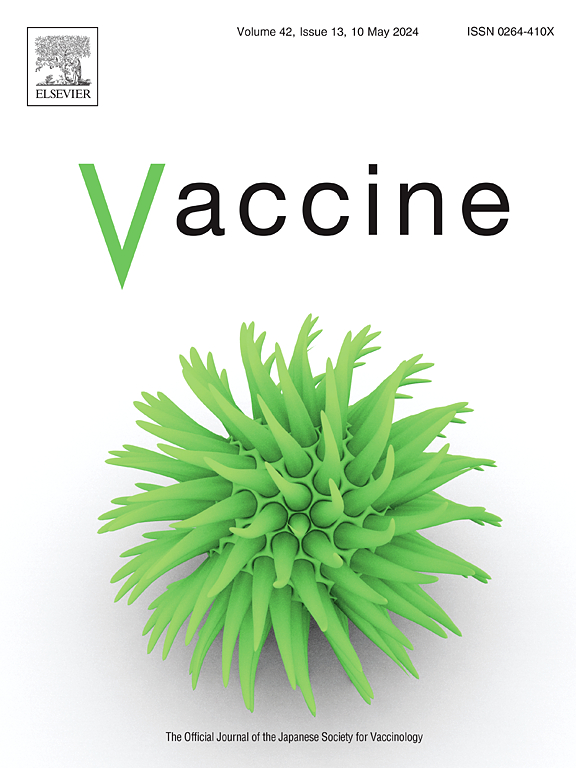Validating community concerns of menstrual changes associated with COVID-19 vaccination using a self-controlled case series analysis of real-world data
IF 4.5
3区 医学
Q2 IMMUNOLOGY
引用次数: 0
Abstract
Objectives
Stories of menstrual changes occurring post COVID-19 vaccination have abounded, with many affected persons expressing frustration their concerns were not being heard. In an era where misinformation is rampant and can fuel vaccine hesitancy it is imperative to address and validate community concerns. We aimed to investigate evidence of increased menstrual disturbances associated with COVID-19 vaccination.
Methods
We adopted a two-pronged approach; firstly, scrutinising social-media for discussions on menstrual changes associated with COVID-19 vaccination using our deep learning framework VaxPulse. Secondly, we analysed a large de-identified Australian general practice dataset to validate any evidence of increased menstrual disturbance presentations for females aged 15–49 years post-COVID-19 vaccination from 1 January 2021 to 28 March 2023, stratified by vaccine platform (adenovirus vector, mRNA, or protein-subunit). We used a self-controlled case series (SCCS) analysis to determine the relative incidence (RI) with 95 % confidence interval (CI) at six weeks post-vaccination and monitored thereafter until a return to baseline for minimum 2 consecutive weeks.
Results
Examining Reddit and Twitter (now X) data, we identified 70,977 posts discussing menstrual cycle irregularities with two prominent peaks since the global COVID-19 vaccine rollout. The SCCS analysis demonstrated increased presentations with a menstrual disturbance diagnosis associated with mRNA COVID-19 vaccination (RI: 1.14, 95 %CI: 1.07, 1.22, P < 0.001). The increase in presentations was still evident at 7 weeks but dissipated by 13 weeks post vaccination. (RI:1.03, 95 %CI: 0.91, 1.16, P = 0.20).
Conclusion
This study demonstrated a transient increase in menstrual change presentations for up to three months following COVID-19 mRNA vaccination. These findings affirm community concerns raised on social media and are important to ensure people who are vaccinated or are considering future vaccines feel heard, supported, and validated. Our analyses highlight the value of using large real-world datasets to gather reliable evidence for public health decision-making.
通过对真实世界数据的自我控制病例系列分析,验证社区对COVID-19疫苗接种相关月经变化的担忧
关于COVID-19疫苗接种后发生月经变化的故事很多,许多受影响的人表示沮丧,他们的担忧没有得到倾听。在一个错误信息猖獗并可能加剧疫苗犹豫的时代,必须解决和确认社区的关切。我们的目的是调查与COVID-19疫苗接种相关的月经紊乱增加的证据。方法采用双管齐下的方法;首先,使用我们的深度学习框架VaxPulse仔细审查社交媒体上关于与COVID-19疫苗接种相关的月经变化的讨论。其次,我们分析了一个大型的去识别的澳大利亚全科医生数据集,以验证2021年1月1日至2023年3月28日接种covid -19疫苗后15-49岁女性月经紊乱症状增加的证据,并按疫苗平台(腺病毒载体、mRNA或蛋白质亚基)分层。我们使用自我控制病例系列(SCCS)分析来确定疫苗接种后6周95%置信区间(CI)的相对发病率(RI),并在此后进行监测,直到至少连续2周恢复基线。研究了Reddit和Twitter(现在是X)的数据,我们发现了70,977条讨论月经周期异常的帖子,其中有两个突出的高峰,自全球推出COVID-19疫苗以来。SCCS分析显示,与mRNA COVID-19疫苗接种相关的月经障碍诊断增加(RI: 1.14, 95% CI: 1.07, 1.22, P <;0.001)。在接种疫苗后7周,呈现的增加仍然明显,但在接种疫苗后13周消失。(ri:1.03, 95% ci: 0.91, 1.16, p = 0.20)。结论:本研究表明,在接种COVID-19 mRNA疫苗后,月经变化症状可短暂增加长达3个月。这些发现证实了社区在社交媒体上提出的担忧,对于确保接种疫苗或正在考虑未来接种疫苗的人感到被倾听、得到支持和认可非常重要。我们的分析强调了使用大型真实世界数据集为公共卫生决策收集可靠证据的价值。
本文章由计算机程序翻译,如有差异,请以英文原文为准。
求助全文
约1分钟内获得全文
求助全文
来源期刊

Vaccine
医学-免疫学
CiteScore
8.70
自引率
5.50%
发文量
992
审稿时长
131 days
期刊介绍:
Vaccine is unique in publishing the highest quality science across all disciplines relevant to the field of vaccinology - all original article submissions across basic and clinical research, vaccine manufacturing, history, public policy, behavioral science and ethics, social sciences, safety, and many other related areas are welcomed. The submission categories as given in the Guide for Authors indicate where we receive the most papers. Papers outside these major areas are also welcome and authors are encouraged to contact us with specific questions.
 求助内容:
求助内容: 应助结果提醒方式:
应助结果提醒方式:


